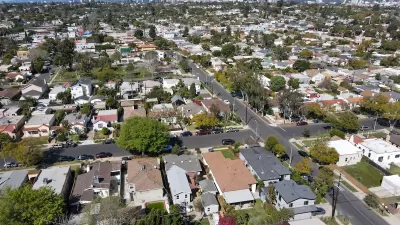Some commentators argue that even if cities allow housing supply to expand, more permissive zoning will cause land prices to increase, causing rents to rise rather than fall. This post disagrees.

The law of supply and demand suggests that if zoning becomes less restrictive, the supply of housing will expand, causing housing to become less expensive. Yet some commentators argue that new supply will not be helpful, because new housing leads to higher land prices. They reason as follows: if you can build more houses on parcel X, you can get more income from that parcel. If you can get more income from parcel X, the market value of parcel X will rise. In turn, future developers will pass the higher cost of land on to homebuyers or renters.
I find this argument unpersuasive for a variety of reasons. First, the argument leads to preposterous results. If it is really the case that new housing increases prices, then prohibiting new housing would lower prices. And if prohibiting new housing lowers price, downzoning (or better yet, demolishing the existing housing supply) would lower prices even more—obviously an absurd result. In fact, aggressive downzoning has been tried in Los Angeles. In 1960, the city was zoned to support 10 million people. By contrast, today the city is zoned for roughly its current population, which means that almost any new construction will require a rezoning. Did housing prices fall? No. In fact, rents, adjusted for inflation, have risen by 55 percent, while median renter income has grown by only 13 percent. Nor did land prices fall. Land values have increased more rapidly than home prices, from just over $86,229 per house in 1984 to $483,692 in 2014.*
Second, as a matter of theory, increased land values need not lead to increased rents: if my parcel was worth $100,000 but now is worth $200,000, I can build one $200,000 unit on my land—but I can also build two $100,000 units, or increase the housing supply by building multiple units costing less than $100,000. As long as zoning does not limit housing supply, land prices may affect the size and height of housing units rather than the price of those units.
Third, the argument would make more sense if land prices were as stable as rents, because if land prices rose and fell rapidly while rents did not, it would appear that the land price/rent link is not very strong. In fact, land prices are quite volatile: in metropolitan New York City metro area, the land price (apparently per house) swung from $99,916 at the end of 1996 to $418,592 at the end of 2006, down to under $225,000 in early 2012, and up to $250,187 in 2014.* Rent was far less volatile, generally increasing over time. Thus, it appears that the link between land prices and rents is modest.
Fourth, if new housing caused rents to increase, the regions that allowed the most new housing would be the regions with the highest rents. But permissive regions such as Dallas and Houston often have pretty low housing prices. (See here for a larger dataset.)
Finally, if increased supply caused rents to increase, rents would never go down unless a city aggressively reduced the housing supply. But in fact this has not been the case; over the past year, rents have started to go down even in some pricey metro areas- even in New York. (By an odd coincidence, construction seems to have increased).
*All data on land and home prices comes from the Lincoln Institute of Land Policy database.

Alabama: Trump Terminates Settlements for Black Communities Harmed By Raw Sewage
Trump deemed the landmark civil rights agreement “illegal DEI and environmental justice policy.”

Planetizen Federal Action Tracker
A weekly monitor of how Trump’s orders and actions are impacting planners and planning in America.

The 120 Year Old Tiny Home Villages That Sheltered San Francisco’s Earthquake Refugees
More than a century ago, San Francisco mobilized to house thousands of residents displaced by the 1906 earthquake. Could their strategy offer a model for the present?

Rural Missouri Transit Service Could Lose State Funding
OATS Transit offers low-cost rides to primarily elderly rural residents with little or no access to other transportation options.

Opinion: California’s SB 79 Would Improve Housing Affordability and Transit Access
A proposed bill would legalize transit-oriented development statewide.

Record Temperatures Prompt Push for Environmental Justice Bills
Nevada legislators are proposing laws that would mandate heat mitigation measures to protect residents from the impacts of extreme heat.
Urban Design for Planners 1: Software Tools
This six-course series explores essential urban design concepts using open source software and equips planners with the tools they need to participate fully in the urban design process.
Planning for Universal Design
Learn the tools for implementing Universal Design in planning regulations.
Clanton & Associates, Inc.
Jessamine County Fiscal Court
Institute for Housing and Urban Development Studies (IHS)
City of Grandview
Harvard GSD Executive Education
Toledo-Lucas County Plan Commissions
Salt Lake City
NYU Wagner Graduate School of Public Service






























